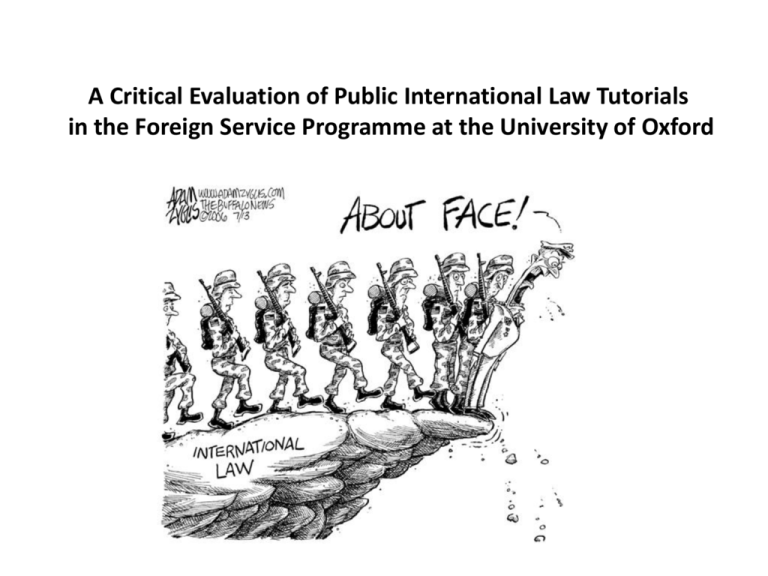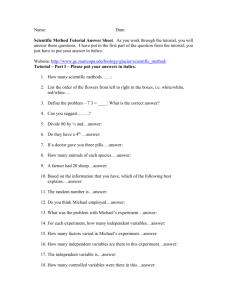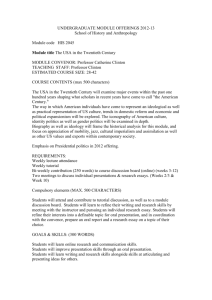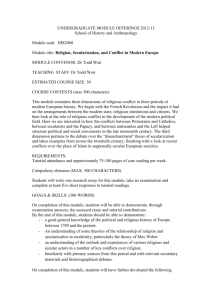A Critical Evaluation of Public International Law Tutorials in the
advertisement

A Critical Evaluation of Public International Law Tutorials in the Foreign Service Programme at the University of Oxford CONTEXT Level of Programme Certificate/Diploma in Diplomatic Studies Module Objectives 1. Students to acquire an academic and working understanding of public international law (one of four core subjects in the Diplomatic Studies course). 2. Desired attributes include: academic literacy, research literacy, and awareness at personal, national and global levels 3. Students are expected to sit for a three-hour written examination, based on questions discussed during tutorials. Student/Learner Profile 1. Multi-national mid-career diplomats comprising 60% male, 40% female. 2. English is a native language to between 2-3 students per cohort. 1 (Concrete Experience) 4 2 (Active Experimentation: Plan & Try Out New Learning Experience) (Observe & Reflect from Feedback and Dialogue) 3 (Analysis & Conceptualisation) 1: Concrete Experience • After a lecture on a topic, students are given 2-3 questions and reading list on the topic for tutorial • Students prepare essay answers to questions of their choice (1,500-2,000 words) • Students present their prepared essays during tutorials with peers and tutor; there are 2-3 students per tutorial • Tutor summarises main learning areas for that particular topic • Current activity is believed to align with objectives of programme in preparing students for a 3 hour written exam 2: Reflection (Using Brookfield’s Four Lenses) Student Feedback (from surveys) 1. Generally essays are difficult to write and poorly structured as students are unclear what is expected of the essay. 2. Students are uncomfortable with a tutorial system comprising so few students (2-3) + 1 tutor. Unprepared students skip tutorial, sometimes leaving only one student attending tutorial. 3. Students find tutorial questions too ‘big’/overwhelming. Peer Dialogue 1. Public international law is one of four subjects students have to prepare for, so they are usually pressed for time. 2. Answering tutorial questions in essay form is the ‘best’ way to prepare students for written exams. Personal Reflection 1. Most students are foreign (since this is a course for international diplomats), where English is not their first language. Even if they have acquired the minimum required EILTS level for entry into the course, writing essays remains challenging. 2. Although students have different learning styles (as per Howard Gardner’s Theory of Multiple Intelligences), they nevertheless possess a sufficient blend of most intelligences to follow the teaching. 3. Students prefer to discuss the topic, rather than have their work ‘assessed’ by peers during tutorials publicly. 3: Analysis & Conceptualisation Analysis of Student 1. Students feel exposed. Tutorials are events that showcase their Feedback ignorance rather than an early assessment point for feedback (Gosling 2009). 2. Structure of required essays should be made known. 3. Link between the tutorials and exams should be made clear. Analysis of Peer Dialogue 1. Belief that writing essays is the ‘best’ way to prepare students for written exams is firmly entrenched. Analysis of 1. The programme could be better designed to respect the range of Personal Reflection language abilities of the individual students (who are largely international diplomats), where English is not their first language. 2. Tutors can continue to teach in their preferred style and remain effective. 3. There should be an alternative/additional means of asking questions or clarifying issues with tutors e.g. via email even after the tutorial if such questions come to mind later. 4: Active Experimentation What can be done immediately 1. Tutorial questions should be broken up into ‘smaller’ shorter questions, dealing with aspects of the topic in parts, and guiding students towards understanding the whole. 2. Students should not need to present their essays, which can be quite intimidating for some. Instead, they could prepare their answers in point form, and submit the full essay after the tutorial. 3. In the tutorial, there should be more generative conversations among students in their exploration of the topic, building on ideas (see Senge [1995]). 4. Students should be informed they can communicate with tutors via email on questions that come to mind even after the tutorial. 5. Have a separate session on how to write legal essays. What can be done in future 1. Tutorial questions could be framed in terms of a scenario or story. This gives a better contextual understanding, and makes the topic less ‘dry’. Accompanying questions will then facilitate a better academic and working understanding of the topic (see Story Centred Curriculum [SCC} by Schank). 2. Introduce role playing games and other interactive activities to engage deeper learning (see Sharp et al [1997]; and Vygotsky [1962])). References • • • • • • • • Brookfield, S. Becoming a Critically Reflective Teacher (1st edn San Francisco: Jossey Bass 1995) Gardner, H. Frames of Mind: The Theory of Multiple Intelligences (1st edn Basic Book 1983) Gosling, D. ‘Supporting Student Learning’ in Fry, H., Ketteridge, S. and Marshall, S. A Handbook For Teaching and Learning in Higher Education (3rd edn Routledge 2009) 113-131 Kolb, D.A. Experiential Learning: experience as the source of learning and development (1st edn New Jersey: Prentice-Hall 1984) Schank, R. Every Curriculum Tells a Story <http://www.socraticarts.com/docs/SCCwhitepaper.pdf> accessed 20 February 2015 Senge, P.M. The Fifth Discipline (1st edn Doubleday/Currency 1990) Sharp J.E., Harb J.N. & Terry R.E. Combining Kolb Learning Styles and Writing to Learn in Engineering Classes [1997] Journal of Engineering Education Vol.86 Issue 2 93-101 Vygotsky, L. Thought and Language (1st edn MIT Press 1962)




